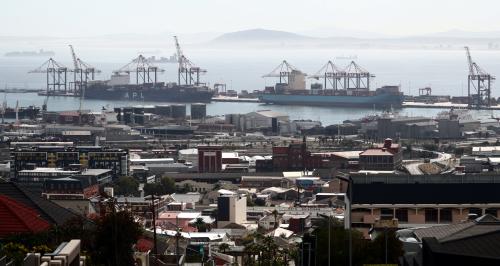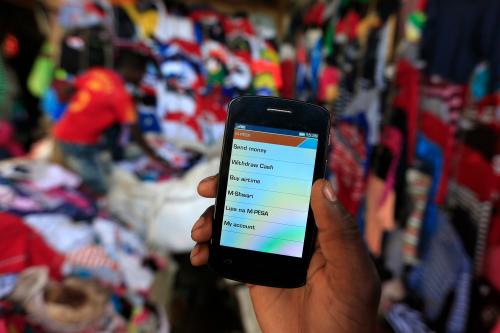The last time I visited Senegal, I was fascinated by how my two nephews (both younger than 10) were negotiating with my brother for him to buy them some airtime. They needed the precious commodity to get an internet connection for their dad’s iPad that he had agreed to lend them for some time. I had proposed my own device but it could not work as their house did not have a wireless connection.
“Can you make my device work too?” I asked. The answer was yes of course. I just needed a paper clip, a mobile phone SIM card, and a scratch card that would give me airtime. I could buy everything from a street vendor from the comfort of a car seat. Then came the (only) tricky part: I had to find a “card cutter” because the local telephone companies’ SIM cards would not fit in an iPad nano-SIM card tray. What’s that? Well, if you look on the side of your device, you will find a card tray that you can open with a paper clip. We found a card cutter downtown, next to the place near city hall where the old pharmacy used to be. It was well worth it because once I received my rightly sized SIM card from the hands of the cutter and inserted it in my iPad, I had an excellent connection to the domestic 3G internet. My brother told me that I could use my connection to make free phone calls overseas using services like VIBER or even try video-conferencing using Skype. I paid less than $15 and could buy more airtime anytime I wanted. I have never known until then that iPads, just as many cell phones, have the ability to connect to the 3G data networks through a micro-SIM card. By the way, I had already bought from one of the three local companies a USB-device manufactured by Huawei that gave me access to the local 3G network too. I just needed to plug it in my computer.
Although I have always been exposed to this type of ingeniosity (we call it “Système D or xooslu” back home), it is always a humbling experience, especially when visiting from the U.S. Think about the value chain involved in the iPad story. It includes Apple, marine cable operators, local telecom companies, street vendors, SIM card cutters, and, if you surf on local websites, all the companies in that sector. Let’s not forget the state as a regulator. I hear now that, for security reasons, you need to show your ID and be registered in order to buy a SIM card.
In her new book, Nigerian-American journalist Dayo Olopade gives the most comprehensive account I have seen of such innovations occurring at the moment in Africa. The driving force of these innovations is what she calls kanju, a “specific creativity born from African difficulty.” Dayo Olopade definitely likes to see things from different perspectives, and she is a keen observer of people. Throughout her book, she uses “maps which layers on top of one another.” Her maps will expose you to the innovative ways in which men and women in Africa are approaching family, technology, commerce, nature and how youth are often leading the way. Her maps zero-in on the men and women of Africa, and she is not a big fan of a top-down or macroeconomic approach. A sectoral analysis is the highest perspective you will get. Her approach is also pluridisciplinary and she is careful to build well-balanced arguments. Don’t let that fool you though, as the book’s tone is often (very) irreverent, which makes it an enjoyable read.
Dayo Olopade’s thesis is that in the “lean” economies of Africa, most of the time people have to exit the formal system controlled by what she calls “fail states” and use innovation to make a change in their lives. In contrast, in the more economically developed “fat” economies, citizens rely on a formal system based on the rule-of-law and enforceable contracts (for instance, a two-year contract from a big telecom company). Now, in African countries, the co-existence of a bottom-up informal system with a top-down formal system creates a legal pluralism. In order to make a change, aid workers, multilateral institutions and other stakeholders have to understand the tools Africans use to avoid the formal system or navigate between the informal and the formal system, to “transform bad government and bad aid into an opportunity to innovate.” Without this understanding, there is a risk of succumbing too often to a “formality bias,” the assumption that only formal institutions can solve Africa’s problems and that success can only be measure through quantitative metrics such as the number of schools built or the number of mothers who died or how free and fair elections were. The author tries to bridge what she calls the “two publics,” the informal and the formal worlds.
Innovations in the informal economy are typically small and the book rightly recognizes the challenge of scaling up solutions in order to reach more people. But one additional issue which could have been explored further is how innovations in one particular country can be successfully adapted to and implemented in other countries.
Though Dayo Olopade is a keen observer of Africa, I would have liked her to tell us more about experiences in other regions. After all, the growth of food trucks and the presence of Senegalese street vendors (who get their supplies from Chinatown) in New York are also a manifestation of kanju, and I am sure that China, India or countries in Latin America have their share of kanju examples.
We all can agree that we cannot propose solutions to Africa’s problems without understanding the informal sector and the people who daily manage to navigate in it, survive and, at times, prosper. After all, according to the African Development Bank, the informal sector contributes about 55 percent of sub-Saharan Africa’s GDP and 80 percent of its labor force. Worse, informality often overlaps with poverty.
It is not surprising that a number of economists have looked at the question of how to harness the energy in the informal sector. Often, their answers tend to push for a formalization of the sector. For instance, the Peruvian economist Hernando de Soto’s 1989 book, “The Other Path,” argues that promoting property rights helps citizens navigate from the informal economy to the formal economy. It would have been useful to have a discussion on the pros and cons of formalization or at least mention the vast literature on informality. But this omission may be on purpose, as what Dayo Olopade is arguing for “the increasingly globalized challenges Africa faces to be addressed with the tools Africans are already using to solve these problems themselves.” If it is the case, she will like the work of the 2009 Nobel Prize winner, Elinor Ostrom who, through the use of field studies, showed that common property can be successfully managed by user associations.
If you are interested in hearing more on the book, I recommend that you attend a conversation with Dayo Olopade on her book at the New America Foundation on Thursday, March 27.
The Brookings Institution is committed to quality, independence, and impact.
We are supported by a diverse array of funders. In line with our values and policies, each Brookings publication represents the sole views of its author(s).







Commentary
A Review of Dayo Olopade’s “The Bright Continent—Breaking Rules & Making Change in Modern Africa”
March 26, 2014